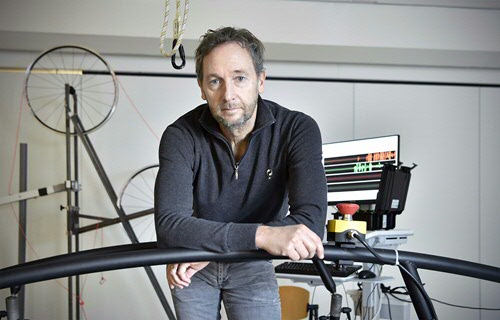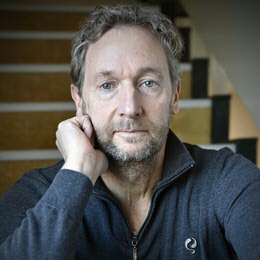De epidemie van lichamelijke inactiviteit
Niet de uitslag van de voetbalwedstrijd Nederland – Estland zal ons lang bijblijven. Wel het statement dat spelers van Oranje maakten tegen racisme. Het is een voorbeeld van de verbindende kracht van sport. Een gesprek met voetballiefhebber en hoogleraar sportwetenschappen Koen Lemmink over de functie van sport en bewegen in de maatschappij.

Tekst: Martin Althof, afd. Communicatie RUG / Foto's: Elmer Spaargaren
Voor Lemmink is sport meer dan sport alleen. ‘Samen sporten creëert een extra dimensie van contact en verbinding. Je ziet de kracht van anderen, moet samenwerken en je kunt winnen of verliezen. Belangrijke elementen om met elkaar een samenleving vorm te kunnen geven.’
Bewegen en kwaliteit van leven
Maar er is meer. Er is steeds meer bewijs dat veel en goed bewegen bijdraagt aan de kwaliteit van leven, voor jong en oud. Lemmink vertelt dat langjarig onderzoek bij bewegingswetenschappen aantoont dat bewegen een positief effect heeft op de cognitieve prestaties van kinderen. ‘En we zijn ook overtuigd van het principe ‘exercise is medicine’. Denk aan fysieke training van patiënten als voorbereiding op een operatie, of aan hardloopprogramma’s voor mensen met depressies. Daarnaast weten we dat veel chronische ziektes te maken hebben met een ongezonde leefstijl. Dan wil je eerder ingrijpen, om ziektes te voorkomen en het verloop van ziektes positief te beïnvloeden.’
Stil zitten en ongezond eten
Wat staat kinderen die geboren worden tussen 2020 en 2040 te wachten? Lemmink is er niet gerust op. De roep om de terugkeer van de vakdocent bewegingsonderwijs op de basisschool klinkt al lang, maar veel verandert er niet. Waarom is bewegen niet een veel belangrijker onderdeel in onze maatschappij? ‘We zien dat de motorische vaardigheden van kinderen afnemen. Kinderen spelen minder op straat, het bewegingsonderwijs staat onder druk. Bovendien zit de maatschappij vol met verkeerde prikkels: ongezond eten, een volle stad, de alom aanwezige beeldschermen. Ik noem dat de epidemie van lichamelijke inactiviteit. Ouders vinden rekenen het belangrijkste vak op de basisschool. Ik denk dat bewegen dat is.’
Topsport helpt breedtesport
Lemmink is betrokken bij het sportbeleid van de gemeente Groningen. ‘Ik benadruk steeds het belang van een goede infrastructuur voor de sportverenigingen. En ook de aanwezigheid van veilige en toegankelijke plekken om te sporten en te bewegen, juist in de wijken. Daarbij moet er extra aandacht komen voor mensen die minder makkelijk gebruikmaken van de voorzieningen. Maar ook de inzet van topsporters van Donar, Lycurgus en FC Groningen kan daarbij stimulerend werken. Topsport helpt breedtesport. Zo moet het zijn.’

Volhouden is moeilijk
Voldoende beweging en gezond eten: iedereen weet dat dat eigenlijk moet. Maar ook dat het lastig is om vol te houden. Lemmink ziet veel initiatieven, kortstondige verbeteringen, maar tevens het daarna weer terugvallen in het oude gedrag. Hij benadrukt dat juist daarom de sociale en fysieke omgeving essentieel zijn. ‘Mensen worden beïnvloed door hun sociale netwerk. Samen naar de sportschool, in een groepje hardlopen of zwemmen. Liefst dicht bij huis; de toekomstige fysieke omgeving moet daar een bijdrage aan leveren. We zullen steden moeten (om)bouwen, zodanig dat wandelen, fietsen en recreëren de ruimte krijgen. De Aletta Jacobs School of Public Health, een samenwerking tussen universiteit, Hanzehogeschool en UMCG zet hierop in.’
Sensoren in voetbalbroekjes
Het onderzoek bij bewegingswetenschappen richt zich in algemene zin op het optimaliseren van menselijk bewegen en bewegingsprestaties van jong tot oud. Lemmink: ‘Door het gebruik van nieuwe technologieën is het mogelijk om bewegingspatronen steeds beter in kaart te brengen. Denk aan de inzet van sensoren, bijvoorbeeld in slidingbroekjes bij voetballers of polsbandjes bij ouderen. We verzamelen zo heel veel data over het menselijk bewegen die we vervolgens analyseren. Speciaal daarvoor hebben we bij bewegingswetenschappen een datawetenschapper aangesteld. Nieuwe kennis die zo wordt ontwikkeld willen we ook toepassen. In de topsport, maar bijvoorbeeld ook in de revalidatie of bij veroudering.’
Personaliseren van kennis
Maar de ene persoon is de andere niet. ‘De volgende stap is het personaliseren van kennis,’ vertelt Lemmink. ‘Op die manier leren we met data het individu steeds beter kennen.’ Als voorbeeld vertelt hij enthousiast over een nieuw project over veerkracht bij sporters, waarbij dagelijks fysieke en mentale gegevens worden verzameld bij de voetbalclubs FC Groningen, PSV en Vitesse. Doel is te achterhalen welke factoren de veerkracht van topvoetballers bepalen en hoe we een afname in veerkracht kunnen zien aankomen om op tijd te kunnen ingrijpen. ‘Deze inzichten kunnen we ook gebruiken bij andere sporten. En ze zijn toe te passen bij werknemers, patiënten en ouderen. Zo zijn er allerlei verbanden tussen topsport, breedtesport, lichamelijke activiteit en het leven van alledag.’
Meer nieuws
-
17 november 2025
Kunstmatige intelligentie in de zorg
-
04 november 2025
AI-Fabriek in Groningen zorgt voor digitale soevereiniteit
-
03 november 2025
Menopauze in perspectief: Hoe de media onze beleving beïnvloeden
